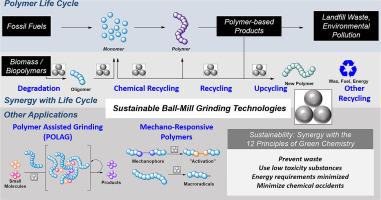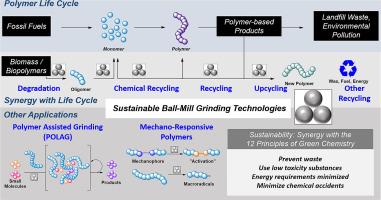Progress toward sustainable polymer technologies with ball-mill grinding
IF 26.1
1区 化学
Q1 POLYMER SCIENCE
引用次数: 0
Abstract
The ball-mill grinding (BMG) of polymers has a long history, starting with Staudinger showing in the 1930s that polystyrene undergoes chain scission upon ball milling. However, BMG has significantly expanded from being used solely for polymer degradation to a synthetic tool for a range of applications only in the last decade. Now, BMG has emerged as a promising mechanochemistry technique for several critically important polymer technologies, such as recycling and upcycling, and often provides novel or enhanced mechanochemical reactivity. As a solid-state technique in which solvents are often minimized or eliminated, BMG provides a greener and more sustainable route to various applications. Also, in contrast to many other mechanochemistry techniques that are commonly employed with polymers, BMG has the potential to be scaled to industrially relevant levels. In our review, we provide an extended and deep overview of the phenomena that occur when polymers are subjected to BMG and show how these phenomena can be exploited for various applications. We treat particularly technologies that, especially in the context of our current plastic pollution crisis, are relevant to trending topics in the field of polymer science, such as polymer degradation, chemical recycling, recycling, and upcycling. Other important topics covered in this review include the mechanical activation of responsive polymers, by the use of mechanophores or by exploiting the reactivity of the reactive intermediates generated during chain scission, and polymer-assisted grinding, where polymers serve as additives or reagents to aid in mechanochemical syntheses or other processes.


利用球磨机研磨实现可持续聚合物技术的进展
聚合物的球磨法(BMG)由来已久,早在 20 世纪 30 年代,施陶丁格(Staudinger)就发现聚苯乙烯在球磨过程中会发生链断裂。然而,直到最近十年,球磨法才从单纯用于聚合物降解,大幅扩展为一系列应用的合成工具。现在,BMG 已成为几种极其重要的聚合物技术(如回收和升级再循环)的一种前景广阔的机械化学技术,并经常提供新的或增强的机械化学反应活性。作为一种固态技术,BMG 通常可以最大限度地减少或消除溶剂,为各种应用提供了更环保、更可持续的途径。此外,与聚合物通常采用的许多其他机械化学技术相比,BMG 有可能扩展到与工业相关的水平。在我们的综述中,我们对聚合物在受到 BMG 作用时发生的现象进行了广泛而深入的概述,并展示了如何在各种应用中利用这些现象。我们特别讨论了一些技术,尤其是在当前塑料污染危机的背景下,这些技术与聚合物科学领域的热门话题息息相关,如聚合物降解、化学回收、循环利用和升级再造。本综述涉及的其他重要主题包括:通过使用机械分子或利用链裂解过程中产生的反应性中间产物的反应性,对反应性聚合物进行机械活化;聚合物辅助研磨,即聚合物作为添加剂或试剂,辅助机械化学合成或其他工艺。
本文章由计算机程序翻译,如有差异,请以英文原文为准。
求助全文
约1分钟内获得全文
求助全文
来源期刊

Progress in Polymer Science
化学-高分子科学
CiteScore
48.70
自引率
1.10%
发文量
54
审稿时长
38 days
期刊介绍:
Progress in Polymer Science is a journal that publishes state-of-the-art overview articles in the field of polymer science and engineering. These articles are written by internationally recognized authorities in the discipline, making it a valuable resource for staying up-to-date with the latest developments in this rapidly growing field.
The journal serves as a link between original articles, innovations published in patents, and the most current knowledge of technology. It covers a wide range of topics within the traditional fields of polymer science, including chemistry, physics, and engineering involving polymers. Additionally, it explores interdisciplinary developing fields such as functional and specialty polymers, biomaterials, polymers in drug delivery, polymers in electronic applications, composites, conducting polymers, liquid crystalline materials, and the interphases between polymers and ceramics. The journal also highlights new fabrication techniques that are making significant contributions to the field.
The subject areas covered by Progress in Polymer Science include biomaterials, materials chemistry, organic chemistry, polymers and plastics, surfaces, coatings and films, and nanotechnology. The journal is indexed and abstracted in various databases, including Materials Science Citation Index, Chemical Abstracts, Engineering Index, Current Contents, FIZ Karlsruhe, Scopus, and INSPEC.
 求助内容:
求助内容: 应助结果提醒方式:
应助结果提醒方式:


